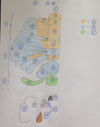Gross anatomy - brainstem, diencephalon, cerebellum Flashcards
Explain the terms:
- prosencephalon
- telencephalon
- diencephalon
- mesencephalon
- rhombencephalon
- metencephalon
- myelencephalon
- brainstem

What are the axes of the brain?
Name and describe them.
- MEYNERT axis: through brainstem
- FOREL axis: through tel-/diencephalon

1 - 6

1) telecenphalon
2) cerebellum
3) lobus frontalis
4) lobus parietalis
5) lobus temporalis
6) lobus temporalis
7 - 12
Another name for #7 and #10.

7) sulcus centralis (ROLANDO)
8) gyrus precentralis
9) gyrus postcentralis
10) sulcus lateralis (SLYVIUS)
11) pons
12) medulla oblongata
1 - 5

1) lobus frontalis
2) fissura longitudinalis cerebri
3) lobus temporalis
4) hemispheria cerebelli
5) vermis cerebelli
6 - 10

6) medulla oblongata
7) pons
8) crus cerebri
9) corpus mammilare
10) pituitary gland
11 - 13

11) chiasma opticum
12) tractus olfactorius
13) bulbus olfactorius
1 - 5

1) corpus callosum
2) gyrus cinguli
3) fornix
4) lumen of III. ventricle/thalamus
5) plexus choroideus of III. ventricle
6 - 10
Another name for #7.

6) chiasma opticum
7) infundibulum hypophysis (stalk of pituitary)
8) pituitary gland
9) corpus mammilare
10) pineal gland
11 - 15
Another name for #12.

11) mesencephalon
12) aqueductus mesencephali (cerebri)
13) lamina tecti
14) IV. ventricle
15) pons
16 - 18
Where is #18 attached to?

16) medulla oblongata
17) velum medullare superius
18) plexus choroideus of IV. ventricle (attached to velum medullare inferius)
Which structures form the rostral and caudal border of medulla oblongata and pons?
- cran. bor. of pons: crura cerebri
- pons - medulla: sulcus bulbopontinus
- caud. bor. of medulla: first cervical nerves
1 - 7
What does #6 and #7 contain?

1) medulla oblongata
2) pons
3) mesencephalon
4) diencephalon
5) sulcus medianus post.
6) fasciculus gracilis (w/ ncl. gracilis)
7) fasciculus cuneatus (w/ ncl. cuneatus)
NOTE: #6 and #7 are FASCICULI, together they form FUNICULUS post.
8 - 14

8) funiculus lateralis
9) tuberculum gracile
10) tuberculum cuneatum
11) velum medullare inf.
12) recessus lateralis of IV. ventricle
13) pedunculus cerebellaris inf.
14) pedunculus cereballaris med.
15 - 21

15) fossa rhomboidea
16) colliculus facialis
17) velum medullare sup.
18) lingula cerebelli
19) pedunculus cerebellaris sup.
20) lamina tecti + colliculus sup.
21) lamina tecti + colliculus inf.
22 - 28

22) brachium colliculi superioris
23) brachium colliculi inferioris
24) crus cerebri
25) area pretectalis
26) thalamus
27) corpus geniculatum med.
28) corpus geniculatum lat.
29 - 31

29) pineal gland
30) fornix
31) lat. ventricle
Which centers do the colliculi sup. and inf. contain?
- sup.: visual reflex centers
- inf.: converging centers of auditory pathway
What is the function of area pretectalis?
controls pupillary light reflex
Which structures form colliculus facialis?
n. facialis bending around ncl. n. abducentis
What are the borders of trigonum lemnisci lateralis?
- rost.: brachium colliculi inf.
- caud.: n. trochlearis
- ventr.: sulcus mesencephali lat.

What are the contents of trigonum lemnisci lateralis?
- dors.: lemniscus lat. (auditory pathway)
- ventr.: lemniscus med. (pyramidal system), lemniscus spinalis (protopathic sens.)

1 - 5

1) eminentia medialis
2) fovea superior
3) locus caeruleus
4) area vestibularis
5) striae medullares
6 - 10

6) colliculus facialis
7) sulcus limitans
8) fovea inferior
9) taenia cinerea
10) vellum medullare inf.






























